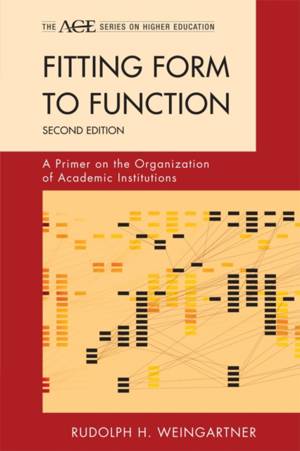
- Afhalen na 1 uur in een winkel met voorraad
- Gratis thuislevering in België vanaf € 30
- Ruim aanbod met 7 miljoen producten
- Afhalen na 1 uur in een winkel met voorraad
- Gratis thuislevering in België vanaf € 30
- Ruim aanbod met 7 miljoen producten
Zoeken
Fitting Form to Function
A Primer on the Organization of Academic Institutions
Rudolph H Weingartner
Paperback | Engels
€ 102,45
+ 204 punten
Omschrijving
Institutions of higher education are not like corporations: they have multiple goals, not even limited to the central ones of teaching and research, nor are they organized hierarchically. One class of leading inhabitants, faculty members, are a cross between independent contractors and employees; another class, administrators, are a cross between bosses and colleagues. Fitting Form to Function discusses how such institutions are best organized; how decisions are best made at various levels; how administrators and faculty can effectively collaborate in giving shape to a university or college. The book takes up such topics as the office of the president, of the provost, the dean and the chairperson of a department. It considers how committees are formed to function effectively-from a faculty senate to budget and planning committees to those that advise on promotions and others that adjudicate when there are grievances. Fitting Form to Function is written in an informal style. No jargon, no footnotes, but sporting 27 recurring maxims, such as Maxim 1, In academic institutions, the forces of nature are centrifugal; organizational art must be used to create propensities toward coherence; Maxim 17, Boundaries are less likely to create solidarity among those who live within them than they constitute barriers for those residing outside them; and Maxim 23, 'A' people hire (or retain) 'A' people, while 'B' people hire 'C' people.
Specificaties
Betrokkenen
- Auteur(s):
- Uitgeverij:
Inhoud
- Aantal bladzijden:
- 168
- Taal:
- Engels
Eigenschappen
- Productcode (EAN):
- 9781442211995
- Verschijningsdatum:
- 21/06/2011
- Uitvoering:
- Paperback
- Formaat:
- Trade paperback (VS)
- Afmetingen:
- 152 mm x 229 mm
- Gewicht:
- 254 g

Alleen bij Standaard Boekhandel
+ 204 punten op je klantenkaart van Standaard Boekhandel
Beoordelingen
We publiceren alleen reviews die voldoen aan de voorwaarden voor reviews. Bekijk onze voorwaarden voor reviews.











